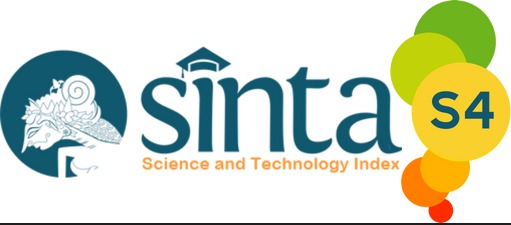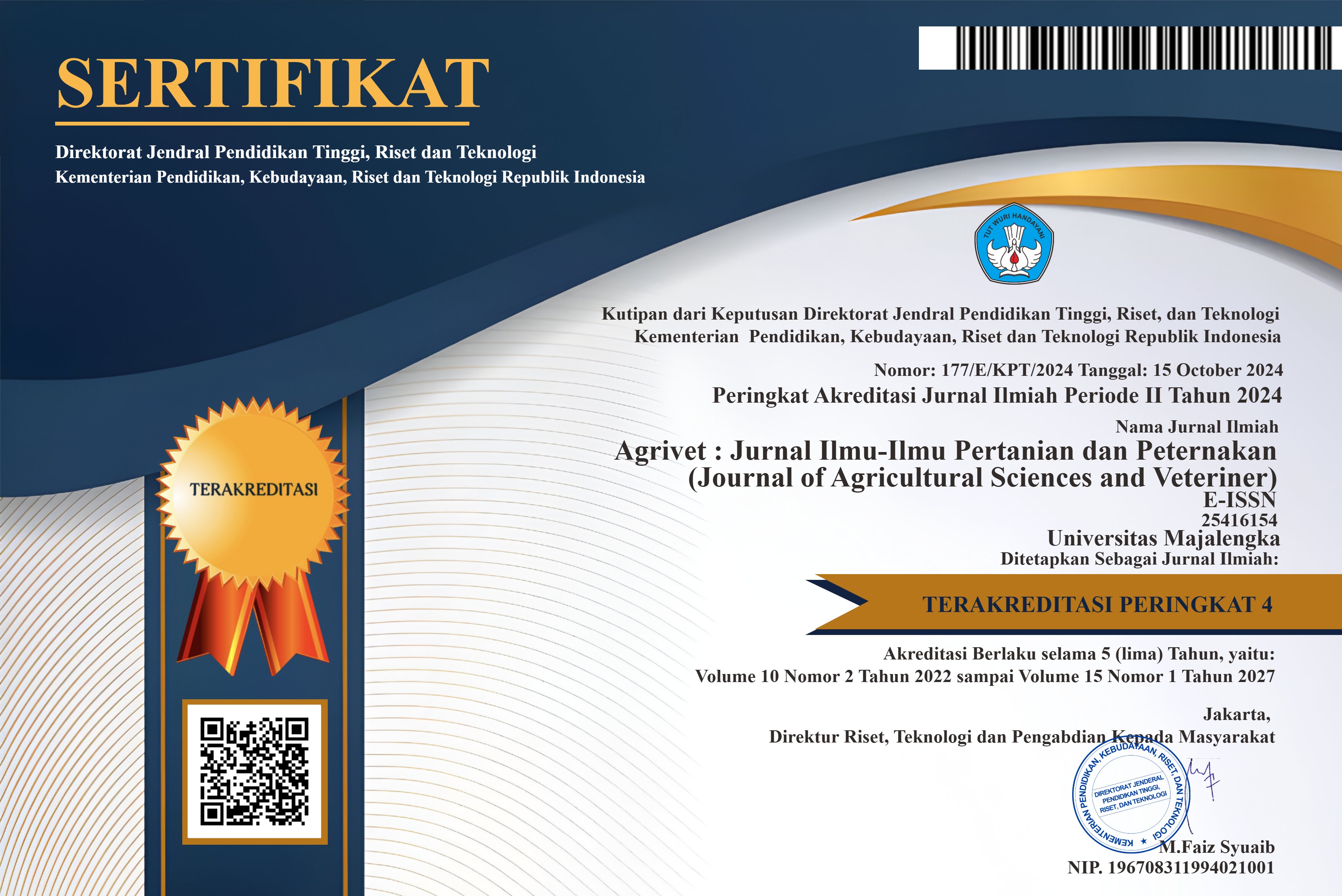Pengaruh aplikasi Trichoderma harzianum terhadap pengendalian jamur Fusarium oxysporum pada tanaman bayam brazil (Alternanthera sissoo)
Trichoderma sp. is one of the biological control agents that can be used to manage soil-borne pathogens, including Fusarium sp. This study aimed to determine the effect of Trichoderma sp. on the growth, yield, and effectiveness in controlling fusarium wilt in Brazilian spinach (Alternanthera sissoo). The experiment used a Completely Randomized Design (CRD) with four treatments and six replications. The study was conducted in the Paranet Screen House, Sidobunder Village, Puring Subdistrict, Kebumen Regency. The treatments consisted of Trichoderma sp. doses of 0 g/plant (control), 10 g/plant, 20 g/plant, and 30 g/plant. Data were analyzed using analysis of variance followed by an Honest Significant Difference (HSD) test at the 0.05 significance level. The results indicated no occurrence of fusarium wilt in plants treated with any dose of Trichoderma sp. or in the control treatment. This was presumed to be due to environmental conditions that were unfavorable for the growth of Fusarium sp. A dose of 10 g/plant of Trichoderma sp. resulted in optimal growth and yield for Brazilian spinach (Alternanthera sissoo).
DOI:
https://doi.org/10.31949/agrivet.v13i1.14222Abstract
Trichoderma sp. is one of the biological control agents that can be used to manage soil-borne pathogens, including Fusarium sp. This study aimed to determine the effect of Trichoderma sp. on the growth, yield, and effectiveness in controlling fusarium wilt in Brazilian spinach (Alternanthera sissoo). The experiment used a Completely Randomized Design (CRD) with four treatments and six replications. The study was conducted in the Paranet Screen House, Sidobunder Village, Puring Subdistrict, Kebumen Regency. The treatments consisted of Trichoderma sp. doses of 0 g/plant (control), 10 g/plant, 20 g/plant, and 30 g/plant. Data were analyzed using analysis of variance followed by an Honest Significant Difference (HSD) test at the 0.05 significance level. The results indicated no occurrence of fusarium wilt in plants treated with any dose of Trichoderma sp. or in the control treatment. This was presumed to be due to environmental conditions that were unfavorable for the growth of Fusarium sp. A dose of 10 g/plant of Trichoderma sp. resulted in optimal growth and yield for Brazilian spinach (Alternanthera sissoo).
Keywords:
Biological Agents, brazilian spinach, Fusarium, pathogenDownloads
References
Han Y, Sun T, Tang Y, Yang M, Gao W, Wang L, Sui C. 2024. Root rot in medicinal plants: a review of extensive research progress. Front Plant Sci. 15(February):1–20. https://doi.org/10.3389/fpls.2024.1504370
Ningsih H, Utami SH, Dwi L. 2016. Kajian Antagonis Trichoderma Spp . terhadap Fusarium solani Penyebab Penyakit Layu pada Daun Cabai Rawit (Capsicum frutescens) Secara In Vitro. Proceeding Biol Educ Conf. 13(1):814–817.
Novita N, Firmansyah E, Isnaeni S. 2021. Keefektifan Trichoderma sp. dalam Mengendalikan Layu Fusarium pada Tanaman Mentimun (Cucumis sativus L.). AGROSCRIPT J Appl Agric Sci. 3(1):19–30. https://doi.org/10.36423/agroscript.v3i1.621
Rahmawati I. 2023. Efektivitas Penggunaan Cendawan Antagonis Trichoderma Harzianum Untuk Pengendalian Penyakit Layu Pada Tanaman Bawang Merah. J Compr Sci. 2(5):1133–1144. https://doi.org/10.59188/jcs.v2i5.329
Sepwanti C, Rahmawati M, Kesumawati E. 2016. Pengaruh varietas dan dosis kompos yang diperkaya Trichoderma harzianum terhadap pertumbuhan dan hasi tanaman cabai merah (Capsicum annuum L.). J Kawista …. 1(1):68–74.
Sharma B, Yadav L, Pandey M, Shrestha J. 2022. Application of Biofertilizers in crop production: A review. Peruvian J Agron. 6(1):13–31. https://doi.org/10.21704/pja.v6i1.1864
Susilawati S, Wijaya, Harwan. 2017. Pengaruh Takaran Pupuk Nitrogen Dan Jarak Tanam Terhadap Pertumbuhan Dan Hasil Tanaman Selada (Lactuca sativa L.). J Agrijati. 31(3):82–92.
Sutarman. 2018. Potensi Trichoderma harzianum Sebagai Pengendali Fusarium oxysporum Penyebab Busuk Pangkal Batang Tanaman Cabai Merah (Capsicum annum L.). Agritech. 19(2).
Tyśkiewicz R, Nowak A, Ozimek E, Jaroszuk-ściseł J. 2022. Trichoderma : estado actual de su aplicación en la agricultura para el biocontrol de hongos fitopatógenos y la estimulación del crecimiento vegetal. Rev Int Ciencias Mol [Internet]. 23(4):2329. https://www.mdpi.com/1422-0067/23/4/2329/htm%0Ahttps://www.mdpi.com/1422-0067/23/4/2329
Published
How to Cite
Issue
Section
License
Copyright (c) 2025 Muhamad Maulana, Aulia Rahmawati

This work is licensed under a Creative Commons Attribution-ShareAlike 4.0 International License.
An author who publishes in the Jurnal Agrivet agrees to the following terms:
- Author retains the copyright and grants the journal the right of first publication of the work simultaneously licensed under the Creative Commons Attribution-ShareAlike 4.0 License that allows others to share the work with an acknowledgment of the work's authorship and initial publication in this journal
- The author is able to enter into separate, additional contractual arrangements for the non-exclusive distribution of the journal's published version of the work (e.g., post it to an institutional repository or publish it in a book) with the acknowledgment of its initial publication in this journal.
- The author is permitted and encouraged to post his/her work online (e.g., in institutional repositories or on their website) prior to and during the submission process, as it can lead to productive exchanges, as well as earlier and greater citation of the published work











